Volcanic Eruption Update ? July 16, 2025
A new eruption began shortly before 4 AM on July 16 in the Sundhnúkur fissure, just north of Grindavík on Iceland's Reykjanes Peninsula. The eruption was preceded by a noticeable seismic swarm beginning around midnight, triggered by underground magma movement.
As a precaution, both Grindavík and the Blue Lagoon were safely evacuated. Authorities continue to monitor the eruption closely.
Key Takeaways
- A new volcanic eruption began at 3:57 AM on July 16 in the Sundhnúkur crater row.
- Grindavík and the Blue Lagoon have been evacuated as a safety measure.
- Air traffic to and from Iceland remains unaffected.
- The eruption is highly localized, with no impact on infrastructure outside the immediate area.
- The eruption zone and Grindavík are currently closed to the public.
Current Conditions and Safety Measures
The Icelandic Meteorological Office, alongside the Department of Civil Protection and University of Iceland scientists, is monitoring the situation in real time.
- Current assessments show no immediate threat to infrastructure from the lava flow.
- The eruption is limited to the Sundhnúkur area and has not disrupted essential services.
- Visitors are strongly advised not to approach the area, which remains closed.
If you're traveling in or near the Reykjanes Peninsula, keep an eye on gas pollution updates, especially sulfur dioxide levels, which can vary based on wind conditions.
Check air quality status here: Air Quality in Iceland
Impact on Travel and Tourism
Despite the eruption, Iceland remains fully open to visitors.
Here's what you need to know:
- Airports across Iceland are operating normally.
- International and domestic flights are on schedule.
- Most tourist attractions?including those in Reykjavík, the South Coast, and the Golden Circle?are unaffected.
For road safety and travel alerts:
Iceland's Resilient Infrastructure
Volcanic activity is a normal part of life in Iceland, and the country is exceptionally prepared.
- Buildings and infrastructure are designed with geological activity in mind.
- Emergency response teams are trained for rapid deployment during eruptions.
- Past eruptions in the area have had no impact on international air travel or broader public safety.
Context: A Volatile Region
This is now the eighth eruption on the Reykjanes Peninsula since December 2023, underscoring the region's ongoing geological activity. Most have been short-lived and localized, posing minimal threat to the broader public.
To learn more about Iceland's volcanic systems and safety procedures, watch this informative breakdown by Dr. Matthew Roberts from the Icelandic Meteorological Office:
Summary for Travelers
- Iceland is safe and open for tourism.
- Stay informed through reliable sources.
- Respect local warnings and closures.
- Enjoy the rest of Iceland's natural beauty with confidence.
Last updated: July 16, 2025
Sources: Icelandic Meteorological Office, Civil Protection, SafeTravel.is
Update April 1, 2025
New Eruption Near Grindavík - Evacuations Underway
As of April 1, 2025, a new volcanic eruption has begun near the town of Grindavík on Iceland's Reykjanes Peninsula. This marks another chapter in the ongoing seismic activity in the region.
The eruption began around 6:30 a.m. local time, following a spike in earthquake activity. A 500-meter fissure has opened, releasing lava that has breached the protective barriers north of Grindavík.
Evacuations and Safety Measures
- Authorities have evacuated Grindavík, including approximately 40 homes in the town.
- The Blue Lagoon geothermal spa, one of Iceland's most visited tourist destinations, has also been evacuated and closed temporarily.
- Emergency sirens were activated in the early morning to alert residents.
- Civil protection teams are on site and continue to monitor the situation closely.
Air Travel and Tourism Impact
- Flights to and from Iceland remain unaffected.
- All airports are open and operating on normal schedules.
- Tourism services outside the affected area continue as usual.
- Travelers are encouraged to check local advisories and be flexible with plans near Grindavík.
What Travelers Should Know
- Iceland remains a safe destination, but travelers should stay up to date on developments.
- The eruption zone and surrounding areas are strictly off-limits to the public.
- Access roads may be closed depending on lava flow direction and seismic conditions.
Ongoing Monitoring and Scientific Assessment
The Icelandic Meteorological Office and Civil Protection continue to monitor magma movement and issue real-time updates. Due to the dynamic nature of the situation, conditions may evolve rapidly, and further evacuations or closures may follow.
Recommendations for Travelers
-
Stay Updated via official sources:
-
Respect all closures ? attempting to access the eruption area is dangerous and prohibited.
-
Be prepared ? monitor alerts, adjust itineraries if necessary, and follow instructions from local authorities.
Summary
Despite this new eruption near Grindavík, Iceland remains open for tourism. Flights are running, services are operating, and the majority of the country is unaffected. Iceland's emergency response is strong, and travelers can feel confident with proper planning and awareness.
Last updated April 1, 2025 ? based on data from the Icelandic Meteorological Office and AP News
Source: AP News ? Iceland Volcano
Update January 31, 2025
No Ongoing Volcanic Activity, But Continued Monitoring
As of January 31, 2025, there is no ongoing volcanic eruption on the Reykjanes Peninsula. The most recent eruption, which began on November 20, 2024, lasted 18 days before concluding on December 8, 2024. This event marked the seventh eruption in the region since December 2023, producing a lava field covering approximately 9 square kilometers with an estimated 49.3 million cubic meters of lava.
Despite the pause in activity, the Icelandic Meteorological Office continues to closely monitor the region. Magma accumulation beneath the Svartsengi area suggests that future eruptions remain possible, although there are currently no immediate signs of an impending event.
Travel Information and Safety Measures
Air Travel: Flights to and from Iceland remain unaffected. All airports are operating normally.
Tourism Services: All attractions, including the Blue Lagoon and Reykjavík's popular sites, are open and fully operational.
Restricted Areas: The eruption zone remains closed to the public due to ongoing monitoring and safety concerns.
Authorities have demonstrated efficient volcanic management throughout the past year, ensuring minimal disruption to daily life and tourism. Visitors are encouraged to follow official updates and adhere to safety guidelines if seismic activity increases.
Stay Updated
For the latest information on seismic activity, travel safety, and road conditions, follow these reliable sources:
- Icelandic Meteorological Office ? Updates on volcanic activity and weather conditions
- Icelandic Road Administration ? Information on road closures and travel routes
- SafeTravel Iceland ? Safety advisories for travelers
While Iceland's geological activity remains dynamic, the country is well-prepared for such events, making it a safe and extraordinary destination to visit. Travelers are advised to stay informed and enjoy Iceland's incredible landscapes with confidence.
Volcanic Activity in Iceland - 21st november 2024
A new chapter in Iceland's remarkable volcanic history unfolded near Grindavík on November 20 at 11:14 PM, with the eruption of a fissure by Sundhnúksgígar crater. This marks the seventh volcanic eruption in the area since December 2023, continuing the dynamic geological activity characteristic of the Reykjanes Peninsula.
What Does This Mean for Visitors?
First and foremost, Iceland remains a safe and fully operational destination. Visitors can rest assured that:
- Air travel to and from Iceland is unaffected; all airports are open, and flights are running on schedule.
- The eruption's impact is localized, with road closures near the eruption site but no disruptions to major travel routes.
- All tourism services across Iceland are functioning normally, with no interruptions to planned activities beyond the affected area.
While the eruption has drawn global attention, it's important to emphasize that Iceland's volcanic events are carefully monitored, and safety is a top priority.
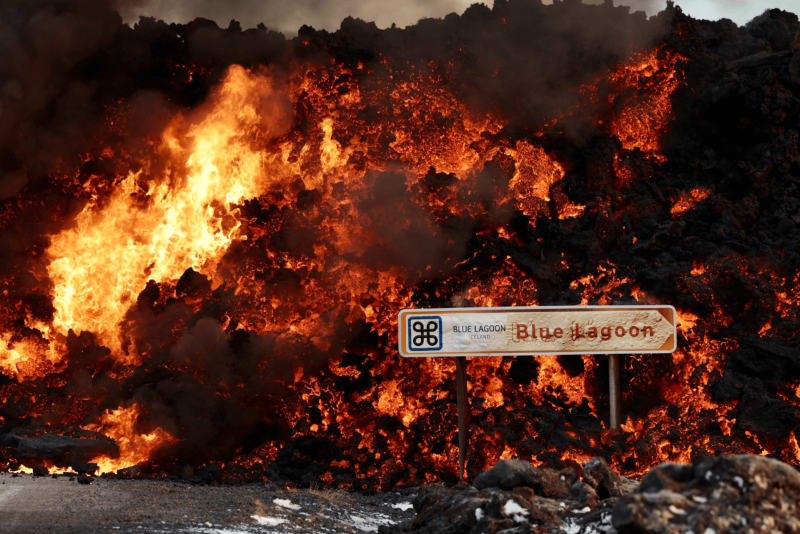
A Country Prepared for Volcanic Events
Iceland is highly experienced in managing volcanic activity, with robust protocols and well-trained authorities. Key points include:
- Monitoring and readiness: Icelandic authorities and geoscientists are on constant alert to ensure the safety of residents and visitors alike.
- Infrastructure resilience: Iceland's infrastructure is designed to withstand seismic and volcanic events, ensuring minimal disruption to daily life.
- Evacuations and precautions: Grindavík has been evacuated intermittently since November 10 to protect residents, although no further evacuations are currently needed.
Volcanic History of the Reykjanes Peninsula
This latest eruption adds to a sequence of volcanic events in the region, with previous eruptions occurring in 2021, 2022, and 2023. Such activity stems from increased geophysical activity observed by the Icelandic Meteorological Office since October last year.
Although dramatic, fissure eruptions like this one generally pose minimal risk to broader areas, making them more of a visual spectacle than a hazard. However, visitors must adhere to official guidance:
- The eruption area is closed to the public for safety reasons.
- Roads around the site have been closed, and attempts to access the area are prohibited.
Stay Informed
For the latest updates on the eruption and travel conditions, visitors are encouraged to follow trusted sources:
- The Icelandic Road Administration: Updates on road closures in the Reykjanes region.
- Safetravel: Safety advisories and traveler information.
- The Icelandic National Broadcasting Service (RÚV): News and coverage of the eruption.
- Visit Iceland: Official updates for travelers.
Volcanic Eruption 22nd of August 2024
Important Update for Travelers Regarding Recent Volcanic Activity in Iceland
As of August 22, a new volcanic eruption has begun near the town of Grindavík on the Reykjanes Peninsula. This is the sixth eruption in the area since December 2023. The eruption is confined to the immediate area around the Sundhnúksgígar crater and does not pose a threat to the public.
Key Points for Travelers:
-
Air Travel Unaffected: Flights to and from Iceland are operating as usual. All Icelandic airports remain open, and there are no disruptions to air travel.
-
Safety First: The eruption site is closed to the public. We strongly advise against attempting to visit the area. Authorities are closely monitoring the situation to ensure everyone's safety.
-
Normal Operations: All services and tourism activities in Iceland are continuing as normal. The country remains a safe destination for visitors.
The Icelandic Meteorological Office, along with other safety and scientific agencies, are keeping a close watch on the situation. For the latest updates on the eruption and its impact, please refer to the resources below:
For more detailed information, including a video explanation by Dr. Matthew Roberts from the Icelandic Meteorological Office, please watch this YouTube video.
Remember, Iceland is highly experienced in managing volcanic activity, and the country is fully equipped to ensure the safety and well-being of all visitors. If you have any further questions or need assistance, please don't hesitate to contact us.
Stay safe and enjoy your visit to Iceland!
Guidance for Travelers
- Stay Informed: Regularly check updates from the Icelandic Met Office and Civil Defence & civil defense facebook page. Utilize apps and websites that provide real-time seismic activity data.
- Follow Local Advice: Adhere to all travel advisories and restrictions issued by Icelandic authorities. Avoid visiting Grindavík and other affected areas.
- Emergency Contacts: Keep a list of emergency contacts, including local authorities, embassies, and healthcare services.
- Travel Insurance: Ensure your travel insurance covers natural disasters and understand the terms regarding volcanic activity.
- Plan Alternative Routes: Be prepared to adjust your travel plans, including accommodations and activities, especially if they involve the affected area.
- Safety Essentials: Carry a basic emergency kit with essentials like water, snacks, a first-aid kit, and a flashlight.
- Communication Preparedness: Keep your phone charged and consider carrying a portable charger. Stay connected with your travel group.
- Respect Emergency Operations: Understand that emergency response efforts are a priority, and your cooperation is crucial.
By following these guidelines, travelers can ensure their safety while still enjoying the unique beauty and experiences Iceland offers.
Other websites to be aware of:
- Local media outlets for updates, including the online National Broadcasting service, RUV, also at RUV Facebook.
- Live webcams of the area are visible here.
- Follow the latest alerts on SafeTravel.is and @safetravel.
- Additional information at Visit Reykjanes and @visitreykjanes.
Volcanic Eruption 29th of May 2024
An eruption has started near Sundhnúkagígjar (Sundhnukscrater, just north of Grindavík. It can be seen on webcams and appears to be located northeast of Sýlingafell.
- The eruption started northeast of Sýlingafell around a quarter to one in the afternoon.
- There was an intense earthquake in the Sundhnúks crater since shortly before eleven this morning.
- Grindavík, the Blue Lagoon and the power plant in Svartsengi were evacuated before noon.
- The National Police Commissioner, in consultation with the police chief in Suðurnes, has declared a state of emergency due to the eruption.
- More magma had accumulated under Svartsengi than before the previous eruption. The eruption crater is still getting longer and stronger.
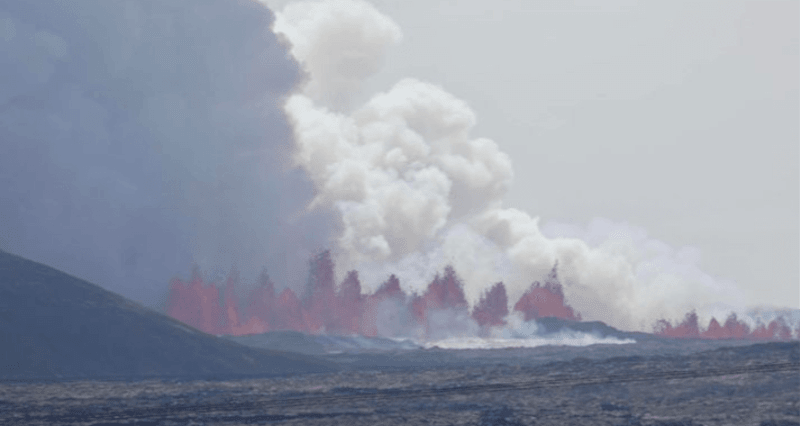
Update March 2024
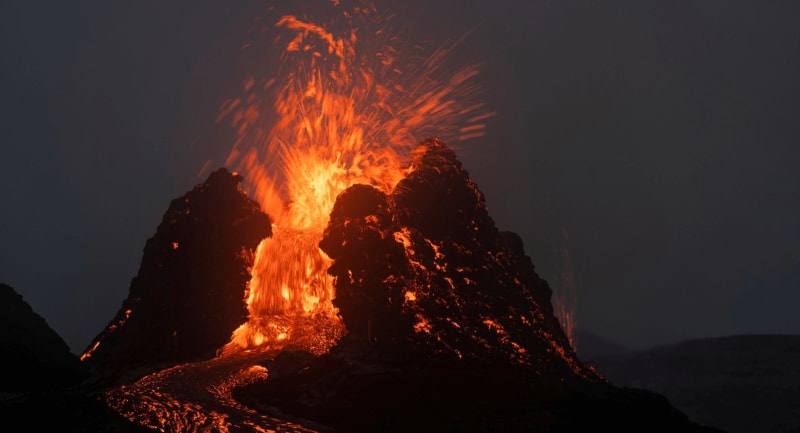
On March 16th, an eruption commenced near Mt. Hagafell on the Reykjanes Peninsula, echoing the events of February 8. This marks the seventh eruption in the area within the last three years, with the initial occurrence dating back to March 19, 2021.
Monitoring and Emergency Response:
The Department of Civil Protection and Emergency Management, alongside local officials, have enacted essential safety protocols. Evacuation procedures are in place for Grindavík, the Blue Lagoon, and Svartsengi regions.
Researchers from the Icelandic Meteorological Office and various universities are analyzing the situation. Comprehensive updates will be provided once the area has been securely evaluated.
Hiking in the area is prohibited. The Blue Lagoon remains closed to the public.
We ask you to respect the closures and stay away from the area.
Update February 8th 2024
Update on Volcanic Activity and Emergency Measures in the Reykjanes Peninsula
As of February 8, 2024, the Reykjanes Peninsula is facing a critical situation due to an ongoing volcanic eruption. The lava flow, which has increased significantly since the early hours, is now perilously close to a crucial hot water pipeline that supplies the entire peninsula. Víðir Reynisson, the director of Civil Defence, has reported that without intervention, the lava could damage this infrastructure within three hours, potentially leaving the region without hot water for an extended period.
Efforts are in full swing to avert this crisis. Emergency teams are working to protect the pipelines and have commenced the installation of a new hot water pipe designed to withstand the lava flow. Residents and businesses in the Suðurnes area are being urged to conserve water to extend the supply for up to 14 hours if the current pipeline is compromised. Restoration of hot water services could take up to three days if the infrastructure is damaged.
The lava has already crossed Grindavíkurvegur, affecting access to the Blue Lagoon, a popular tourist destination now closed due to the eruption. Despite these challenges, flights to and from Iceland remain unaffected, as the eruption does not produce ash that could impair air travel.
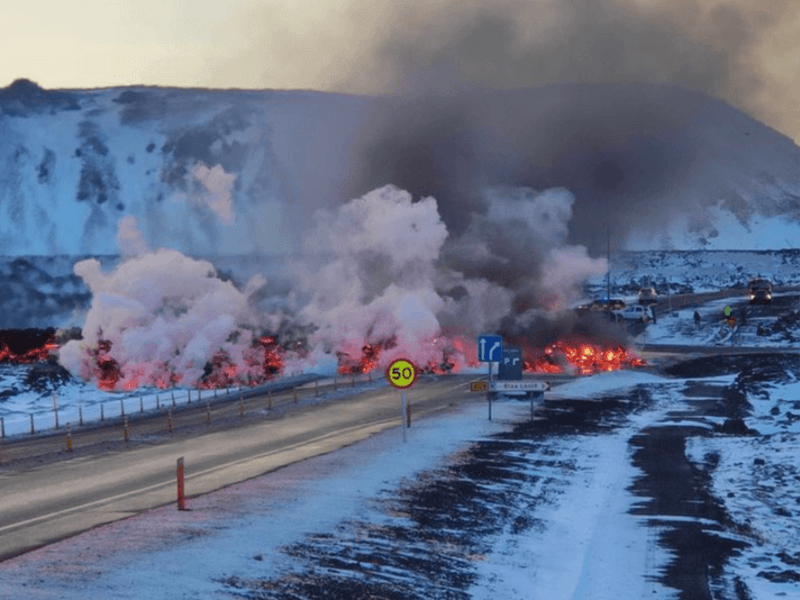
The eruption has attracted attention from both residents and tourists, who have been flocking to safe vantage points to witness the event. This is the third eruption in the area in recent months, with each event closely monitored by the Civil Defence and the Icelandic Meteorological Office.
Authorities are taking all possible measures to protect infrastructure, including electricity pylons, and are prepared with backup generators in Grindavík. The situation remains fluid, and updates from utility companies and emergency services are anticipated.
For those planning to visit or currently renting vehicles in Iceland, it's crucial to stay informed about the situation through reliable sources and adhere to guidance from local authorities. Northbound will continue to provide updates on the situation as it develops, ensuring the safety and convenience of our customers.
Update January 14th 2024
VOLCANIC ERUPTION STARTED ON THE REYKJANES PENINSULA
January 14, 2024
A volcanic eruption started on Sunday, January 14, near Grindavík on the Reykjanes Peninsula. The town had previously been evacuated, and people were not in danger.
Key Takeaways:
- There is a volcanic eruption near the town Grindavík on the Reykjanes Peninsula
- The eruption's effects are confined to the town and the immediate area surrounding the eruption site. All services in Iceland are operating normally
- Flights to and from Iceland are operating on schedule, and disruption to flight traffic is considered highly unlikely
Since October 24, 2023, scientists at the Icelandic Meteorological Office have been carefully monitoring increased seismic activity on the Reykjanes Peninsula, which is considered a possible precursor to a volcanic eruption in the area. This development resulted in a short eruption that lasted from December 18-21, 2023, near the town of Grindavík.
Volcanic activity returned on Sunday, January 14, when lava flow resumed in the area. All residents had previously been evacuated from the town.
Preliminary reports suggest that the lava flows are less voluminous than the previous eruption in December last year. This is a highly localized event, and the effects of the eruption are contained in the immediate area surrounding the eruption site. Iceland generally remains unaffected, and daily life outside of Grindavík proceeds as normal.
While the possibility of air traffic disturbance cannot be entirely ruled out, scientists consider it an improbable scenario. Typically, the impact of volcanic eruptions is confined to a specific, localized area near the eruption. Notably, previous eruptions in the area did not impact flights to and from the country.
The Icelandic Met Office, in collaboration with the Department of Civil Protection and Emergency Management and a team of scientists from the University of Iceland, is actively monitoring the situation and thoroughly analyzing any unfolding developments.
The Icelandic Meteorological Office, The National Police Commissioner, The Department of Civil Protection and Emergency Management, and a team of scientists from the University of Iceland have closely monitored this situation since the beginning and are constantly analyzing developments based on the best scientific data available.
Iceland is situated on the Mid-Atlantic Ridge, where the North American and Eurasian tectonic plates diverge, making it one of the most active volcanic regions in the world. Regular seismic events, ranging from minor tremors to significant earthquakes, are a characteristic feature of Iceland's geology. Seismic activity in Iceland is often due to magma movement beneath the earth's crust. It may sometimes result in magma seeking the easiest path to the surface and becoming a volcanic eruption.
Iceland is no stranger to volcanic activity. Four eruptions have occurred on the Reykjanes Peninsula in the last three years. Icelandic authorities and the public are highly prepared for such events, and Iceland has one of the world's most effective volcanic preparedness measures. Iceland's geoscientists possess vast experience in dealing with volcanic activities.
More information:
- Iceland Ministry for Foreign Affairs
- The Icelandic MET office: Latest information on seismic activity and development of events
- Safetravel: Current updates on safety
- The Icelandic National Broadcasting Service: News coverage
- Visit Reykjanes: Updates from the region
Update 21st of December 2023
- As of Dec. 21, there is no ongoing volcanic activity.
- The effects of the eruption are localized at the eruption site. All services in Iceland are operating per usual.
- If you have plans to visit Iceland, you can continue with your trip.
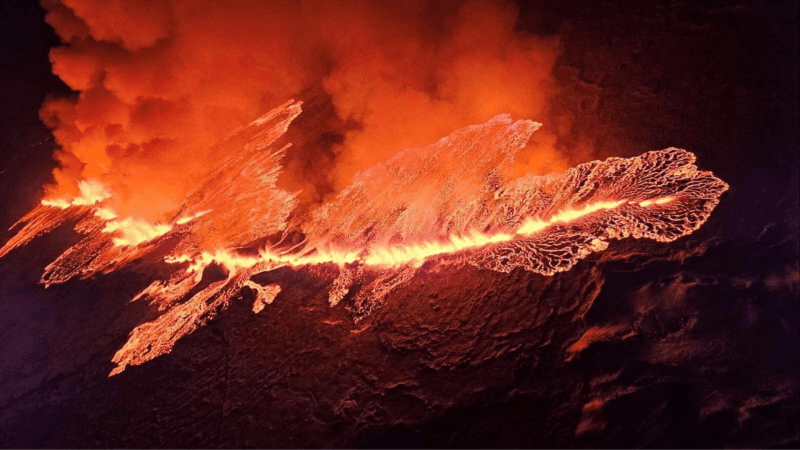
Update 18th of December 2023
- A volcanic eruption started on he Reykjanes Peninsula on Dec. 18.
- The volcanic eruption on Iceland's Reykjanes peninsula does not pose a threat to life, the country's government said in a statement Tuesday.
- The volcanic eruption commenced at 10:17 p.m. local time, located northeast of Grindavik on the Reykjanes peninsula, as stated by government sources. Marking the fourth occurrence of such an event in the region since 2021, this eruption is notably the most extensive to date, featuring a fissure spanning four kilometers (approximately 2.5 miles).
- According to government reports, there have been no disruptions to flight operations into and out of Iceland, and international flight corridors continue to remain operational.
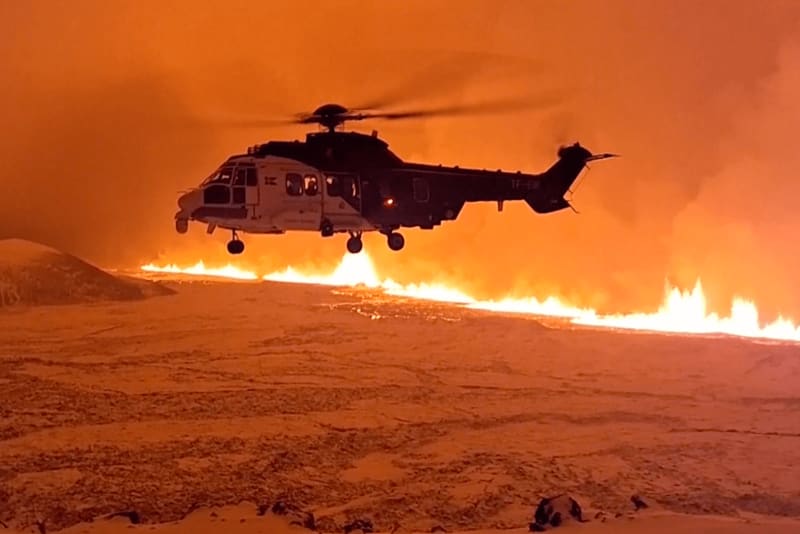
Update 7th of December 2023
- No volcanic eruption has occurred and seismic activities have decreased.
- Residents may now visit Grindavik for extended periods, although residing there is still not permitted.
- Businesses are allowed to operate within specified daily hours.
- The Blue Lagoon remains closed.
Summary
- Iceland is safe for visitors
- Over 22.000 earthquakes recorded in Grindavík
- Magma estimated 500 meters below surface, increased SO2 levels
- Localized response includes Reykjavík service center, infrastructure fortification
- Travel impacts: Blue Lagoon closure, safe travel in other Iceland regions
- Traveler guidance: stay informed, adhere to local advisories
Introduction
In recent days, the picturesque town of Grindavík on Iceland's Reykjanes Peninsula has captured global attention due to its escalating seismic activity. This blog aims to shed light on the situation, providing travelers and locals alike with the latest updates and safety information.
Current Status - A Detailed Overview
As of the latest reports, Grindavík's volcanic activity has intensified, characterized by more than 22.000 recorded earthquakes. This seismic activity centers around the magma intrusion, where thousands of significant quakes have surpassed a magnitude of two, three and four, with 5.1 being the biggest measured earthquake.
Geologists have noted the magma's ascent, now estimated to be approximately 500 meters below the surface, a fact corroborated by heightened levels of sulfur dioxide (SO2) detected in the atmosphere. These indicators point towards a potential eruption, although the exact timeline remains uncertain.
A notable phenomenon accompanying this seismic unrest is the expanding sinkhole within Grindavík. Its continuous growth not only represents geological changes but also poses potential risks to the infrastructure and the local populace.
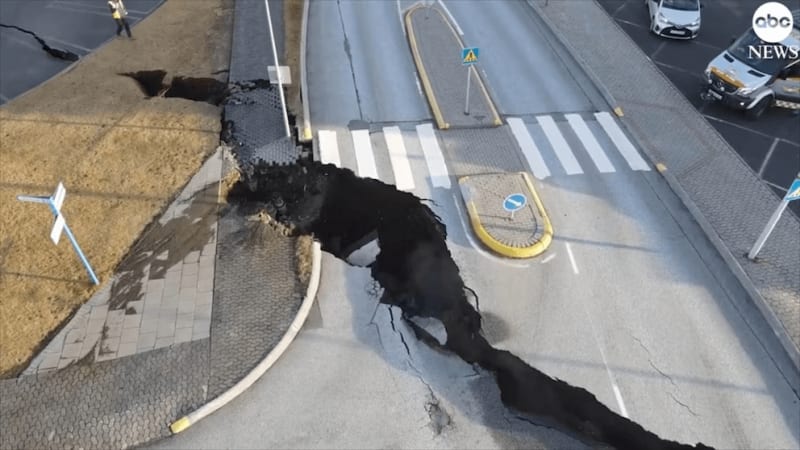
The Icelandic Met Office, in conjunction with international geology experts, continues to analyze the seismic data. Their focus is on understanding the magma's movement and predicting possible outcomes. This includes assessing the likelihood of an eruption and its potential impact on the surrounding area.
While the current seismic activity is concentrated in Grindavík, its effects have rippled through neighboring regions, leading to heightened alertness and preparedness. The situation remains dynamic, with ongoing assessments to track any significant changes in the geological behavior.
The U.S. embassy has also given a statement, find out more here
Safety Measures and Local Response
In response to Grindavík's seismic activity, the Icelandic Met Office and Civil Defence have implemented rigorous monitoring and emergency protocols. A service center has been established in Reykjavík's Customs House at Tryggvagata, offering support and information to both residents and visitors affected by the situation.
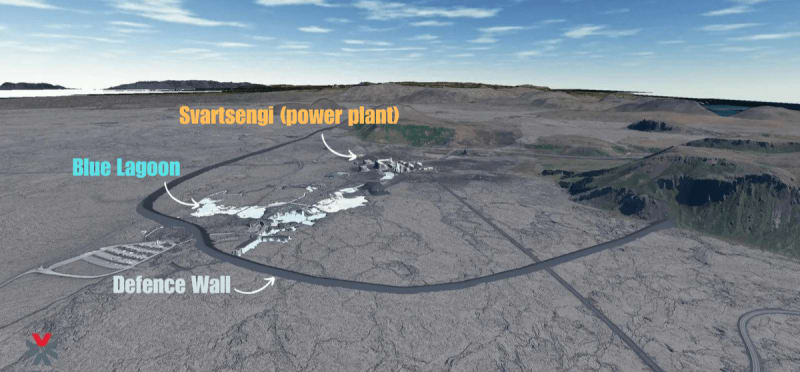
Key infrastructure, such as the Svartsengi power station, is being fortified against potential damage. Authorities are facilitating controlled access to Grindavík, allowing residents to safely retrieve essentials. This process, though challenging due to the circumstances, reflects the commitment to safety and orderly management of the situation.
The collaboration between the National Police Commissioner, the Red Cross, and the local government of Grindavík exemplifies the comprehensive approach taken to address both the immediate and long-term implications of the seismic activity. These efforts underscore the Icelandic authorities' dedication to ensuring the well-being of all those in the affected area.
Impact on Travel and Transportation
The seismic activity in Grindavík has led to disruptions in the local infrastructure, including power outages and structural damages. The town's mayor has indicated that repairs may take months. Notably, The Blue Lagoon, one of Iceland's most iconic attractions, has extended its closure due to the seismic activity in Grindavík. This decision reflects a commitment to safety, both for local residents and international visitors, amidst the ongoing geological changes in the area.
Authorities have been efficiently managing the situation, allowing residents to return temporarily for essential items. However, there has been some frustration regarding the organization of these efforts. Travelers are advised to consider these factors when planning their trips, particularly those intending to visit the Reykjanes Peninsula.
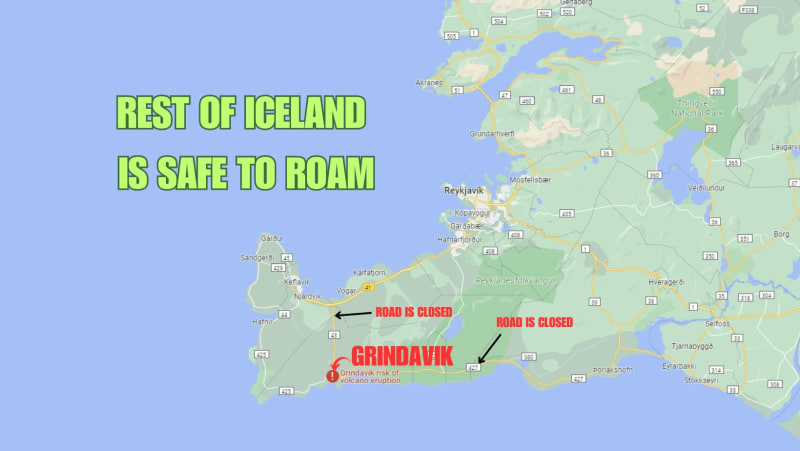
While Grindavík is significantly affected, the rest of Iceland, including its major transport networks, remains operational and safe for travel. Tourists are encouraged to explore other beautiful regions of Iceland, keeping in mind the importance of staying informed and flexible with their travel plans in light of the current situation.
Conclusion
The evolving situation in Grindavík highlights the dynamic nature of Iceland's geology. We remain committed to providing timely updates and urge everyone to prioritize safety, following official guidelines. This event reminds us of the importance of respecting nature's power while exploring the unique landscapes of Iceland.
FAQ
Is it safe to travel to Iceland now?
Yes, it is safe to travel to Iceland. The seismic activity is localized to Grindavík, and the rest of the country remains safe and accessible.
Should I cancel my trip to Iceland because of the volcanic activity?
There's no need to cancel your trip. Stay informed about the situation in Grindavík, but remember that Iceland is well-prepared for geological events.
Can I still visit popular tourist spots outside of Grindavík?
Yes, other tourist destinations in Iceland are unaffected and remain open for visitors.
What precautions should I take while traveling in Iceland?
Stay updated with local news, adhere to travel advisories, and follow guidelines set by Icelandic authorities.
How will this affect my travel plans within Iceland?
While travel within Iceland is largely unaffected, it's good to have flexible plans and check for any travel advisories related to the Grindavík area.
Is the Blue Lagoon open?
The Blue Lagoon is currently closed due to the seismic activity. Check their official website for updates on reopening.
What should I do in case of an emergency?
Keep emergency contacts handy, including local authorities and your embassy. Follow instructions from local officials promptly.
Are there any specific areas in Iceland to avoid?
Currently, it's advised to avoid the immediate area around Grindavík due to seismic activity.
